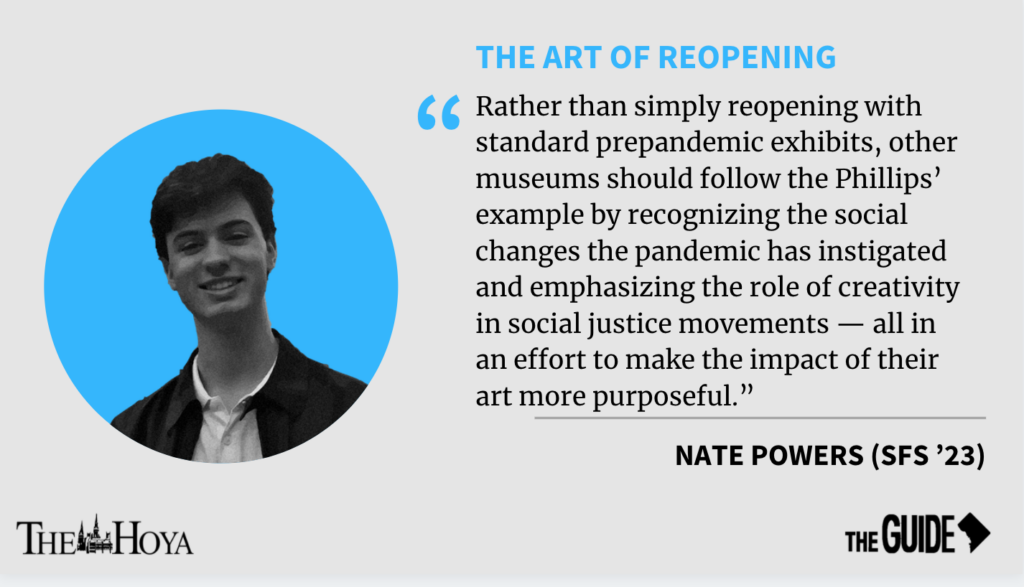The summer of 2021 is poised to be one of the most entertaining in recent memory, as eased public health restrictions across the country are facilitating the reopening of many art venues and exhibition spaces across the world. In Washington, D.C., the gradual reopening of the city’s abundant arts and entertainment spaces means visitors and locals alike will be once again able to enjoy the artistic culture of the city.
At the height of the COVID-19 pandemic, most museums in the District suffered monthslong closures, greatly pausing public engagement. However, this fall, D.C.’s museums gradually started to welcome visitors again, adopting new approaches to comply with public health guidelines.
One of D.C.’s premier museums, the Phillips Collection, reopened its doors in October 2020. Founded in 1921, the Phillips Collection was named in honor of the father of its founder, Duncan Phillips. Phillips was a prominent art critic in the District who spearheaded the effort to create the modern art museum in the city.
Located in northern Dupont Circle, the museum offers patrons the opportunity to see thousands of works of modern art in a personal setting, all set inside the museum’s comfortable and intimate rooms. From the outside, the museum resembles many of the grand brownstones and embassies of Dupont Circle, standing in stark contrast to the larger Smithsonian museums in the center of town.
With its reopening, the Phillips Collection has applied strict social distancing measures by releasing a certain number of tickets at staggered intervals each week. These measures have continued through 2021 in an effort to reduce density within the building.
Although COVID-19 restrictions have increased the difficulty of obtaining tickets to see the Phillips Collection, they have also granted patrons an even more intimate experience in the galleries. Visitors may often find themselves alone in one of the museum’s many rooms, left to enjoy the extensive art collection and building’s historic architecture in peace and solitude.
The pandemic’s influence is also visible in how the museum has curated its current exhibits. In celebrating 100 years of the Phillips Collection this year, its current exhibit, “Seeing Differently,” commemorates the past while also looking toward the future.
The exhibit is organized in a way that exemplifies the lessons humanity has learned throughout the past year, especially in regard to social justice movements that took on new importance during the pandemic. Intimate portraits of African Americans by Whitfield Lovell explore the history of the Black experience in America, placed alongside other African American artists in an effort to further reflect on Black identity.
The sections titled “History,” “Place” and “Identity” have also taken on deeper meanings during pandemic, especially art such as Flor Garduño’s “On the Way to the Cemetery” and Anselm Kiefer’s “Dein blondes Haar, Margarethe,” works that comment both on death and racialization across the globe. These exhibits, paired with the museum’s combined historical Georgian Revival and more modern International Style architecture, allow visitors to reflect on what identity and history have meant to them both before and after the pandemic.
Additionally, the museum has also dedicated certain rooms to art made by people of color, such as international artist Aimé Mpane. The museum aims to feature art that depicts human connection, or, more recently, a lack thereof.
These topics revolving around the human condition are further enhanced by the included voices of its community members in the exhibits. Many of the pieces, particularly those related to racial justice issues in the United States, include messages from local college and high school students. Placards including the students’ own thoughts on the artwork are prominently displayed next to the pieces, as well as ways in which the students think the artwork has taken on new meaning during the pandemic.
By incorporating messages from D.C. locals and highlighting topics and activism related to ongoing social justice movements throughout the country, the Phillips Collection has clearly made a poignant effort to focus its impact through the ways in which it presents its collection.
Other museums reopening should note the efforts of the Phillips Collection to create a meaningful experience for visitors as many patrons begin to reenter these venues after the pandemic. Rather than simply reopening with standard prepandemic exhibits, other museums should follow the Phillips’ example by recognizing the social changes the pandemic has instigated and emphasizing the role of creativity in social justice movements — all in an effort to make the impact of their art more purposeful.















Renée Stout • Jul 19, 2021 at 8:35 am
Having had the opportunity to spend a whole week at the museum, has given me a whole new perspective on the institution. It is apparent that the director, curators and staff are truly working hard to make sure they honor the founder’s beliefs, ideas and mission to support and reflect the community the museum is a part of, especially in troubling times where artistic expression is most needed to help people process and reflect.